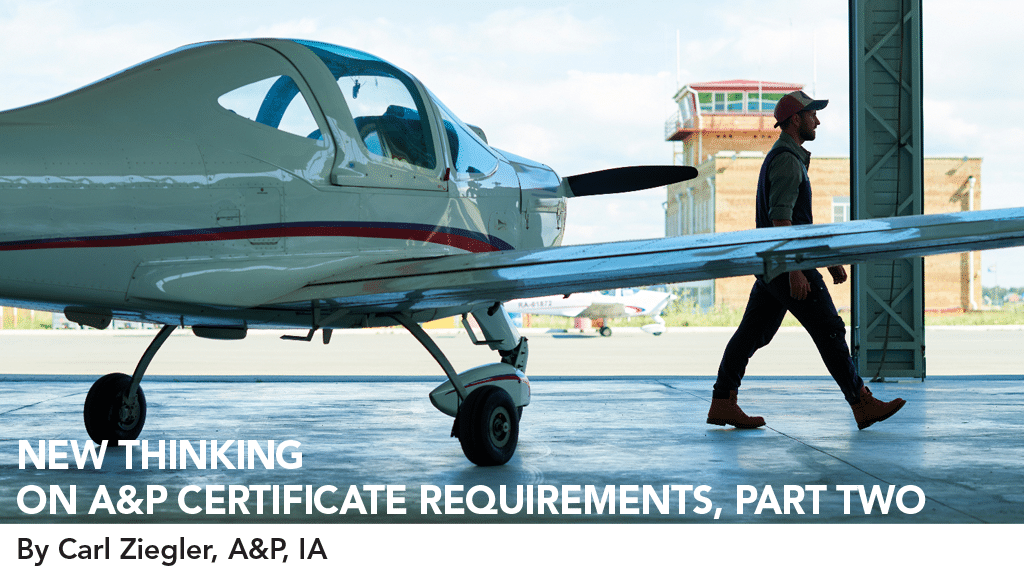If everybody is thinking alike, then somebody isn’t thinking.” This quote is attributed to the late General George S. Patton — patriot, warrior and a general in the U.S. Army — who commanded the troops in World War II in France and Germany after the Allied invasion of Normandy in June 1944. A brilliant tactician and as indicative of the quote, was open to new ideas if something wasn’t working or a process could be done with greater efficiency. Unfortunately, it seems this is not the world we work in, especially when it applies to the government.
I put forth a possible NPRM earlier this year proposing to break the A&P license into an “unlimited rating” and a “limited rating”. The unlimited rating would be afforded those that have gone to an approved part 147 School. General aviation (GA) maintenance skills are continually deteriorating due to the loss of skilled technicians and the influx of new technicians that have only acquired the rating based on tactile time with no formal classroom training. The intent of the proposal was to provide ongoing and future safety margins for the general aviation fleet, in particular, because those individuals that are licensed on a “tactile hours”-based process are not necessarily qualified to work on light aircraft. Conversely, airline maintenance programs are structured and have oversight protection not available in GA part 91 operations. This disparity in the skills gap has grown substantially, specifically in the last five to ten years. I feel it is time for an evolutionary change to help maintain the thin safety margins that we now have.
In response to the NPRM proposal I put forth back in January (see Aviation Maintenance Winter 22/23 issue, page 38), a proposal to help enhance declining skill sets we are experiencing in aviation maintenance fields, the FAA has decided they have other, more pressing issues to deal with. These are the three reasons they cited:
1. The immediacy of the safety or security concerns you raise;
2. The priority of other issues the FAA must deal with; and
3. The resources the FAA has available to address these issues.
But all is not lost, I am so lucky to know that my comments and arguments for the proposed rule changes in my petition will be placed in a database. I am so lucky.
My proposal stressed that safety AND security could be greatly enhanced with absolutely NO cost to the consumer. All this with the stroke of a pen. Of course, the FAA is pretty busy trying to cover all the ATC errors causing close calls. May I point out that it was the skill set of at least one party in each of the recent events that prevented collisions. That party was not the FAA. They are also busy trying to get everyone on board with SMS. The Dynamic Regulatory upgrades have to be eating lots of time from various departments. And thank goodness the FAA has established the “Office of Investigations and Professional Responsibility.” Warm fuzziness all over. I can see why important issues like safety going forward isn’t on the plate.
I was just on the U.S. Bureau of Labor Statistics website. You have it bookmarked, right? Check out the breakdown of aircraft mechanic and service technicians. I could not find any references to skill and pay for anything OTHER than air transport related employments. Seriously? Who maintains the 200,000 General Aviation aircraft? The new part 147 rewrite is solidly aimed to benefit the transport sectors. No dope and fabric and welding. ATEC, which should be looking out for our interests in all aspects of our industry, is amazingly silent on anything outside of high end aviation. On the ATEC site, the Oliver Wyman link states that by 2027 demand for maintenance technicians will outstrip supply by 9%. That was the MRO 2017 survey and again, was only talking air transport. Extrapolate where we are now. In every magazine and website I read, all personnel and skill shortages are referenced to the air transport sectors. If you are an FBO and not affiliated with a major jet center, you tell me what you are seeing for skill sets.
I recently renewed my Inspection Authorization and I found out that due to processing backlogs I was number 400 on the list (last name starts with a Z). Really? There are more than 400 IAs in the state of Minnesota. Major jet centers are expanding across the country but lament the lack of talent that may not materialize with new ventures. COVID killed many smaller FBOs. How are we in aviation going to secure and train qualified warriors to guarantee the safety of our aging fleets? The NPRM I submitted put mentoring in the forefront to support that end. Technically, in Minnesota, we could have 400 IAs available for mentoring newly minted and aspiring technicians. A training force the FAA could never envision, but then again, everybody is thinking alike.
Carl Ziegler is an A&P and IA mechanic and can be reached at planemech@yahoo.com.
